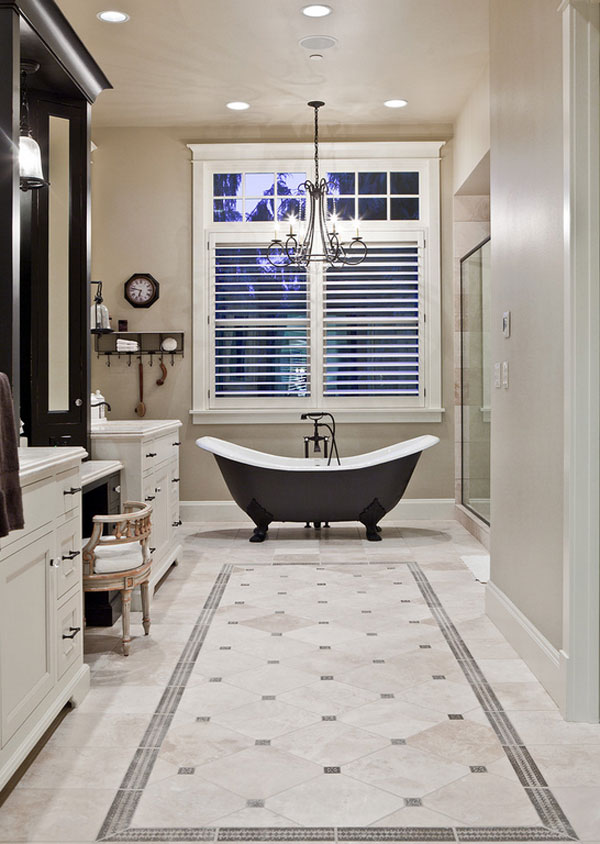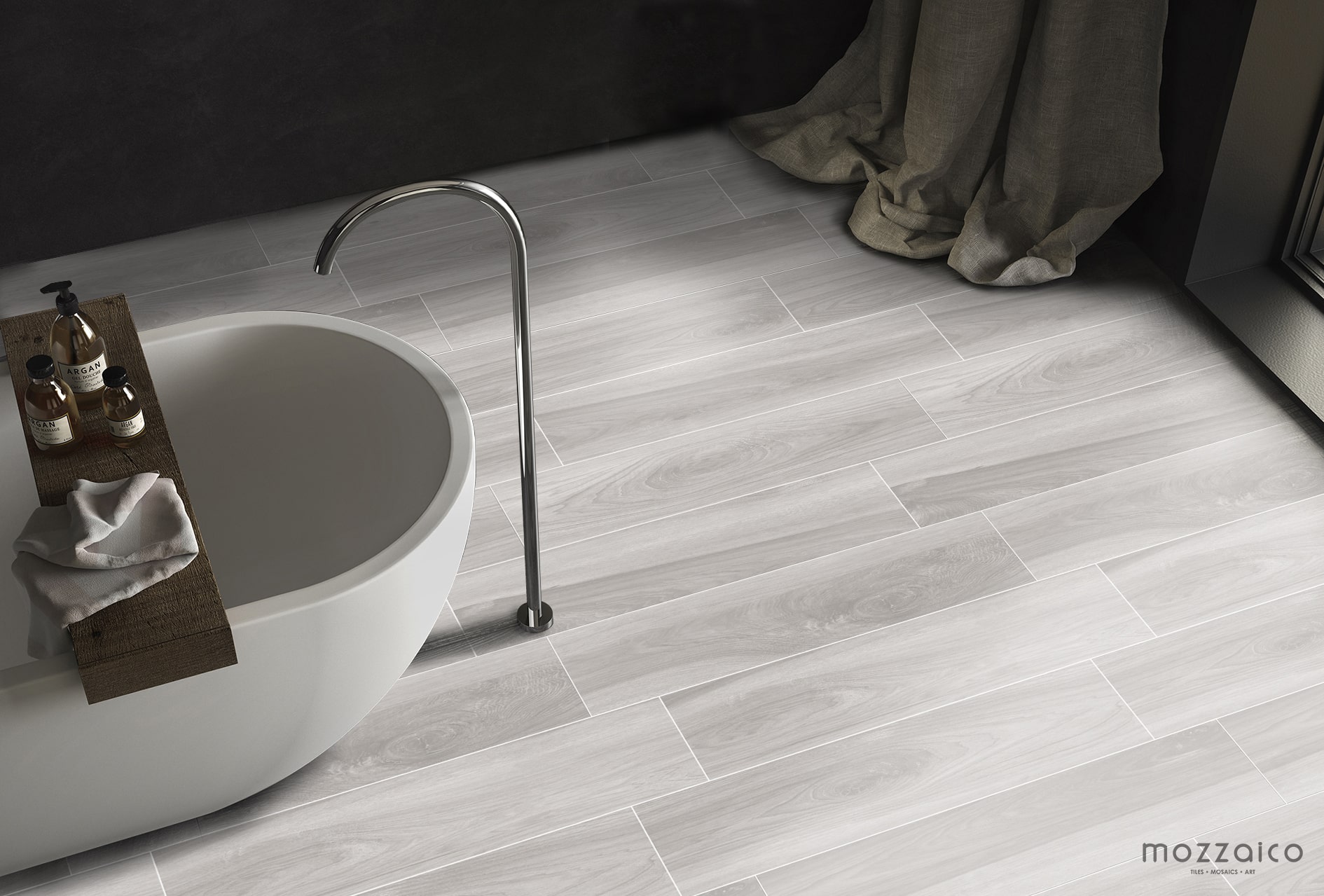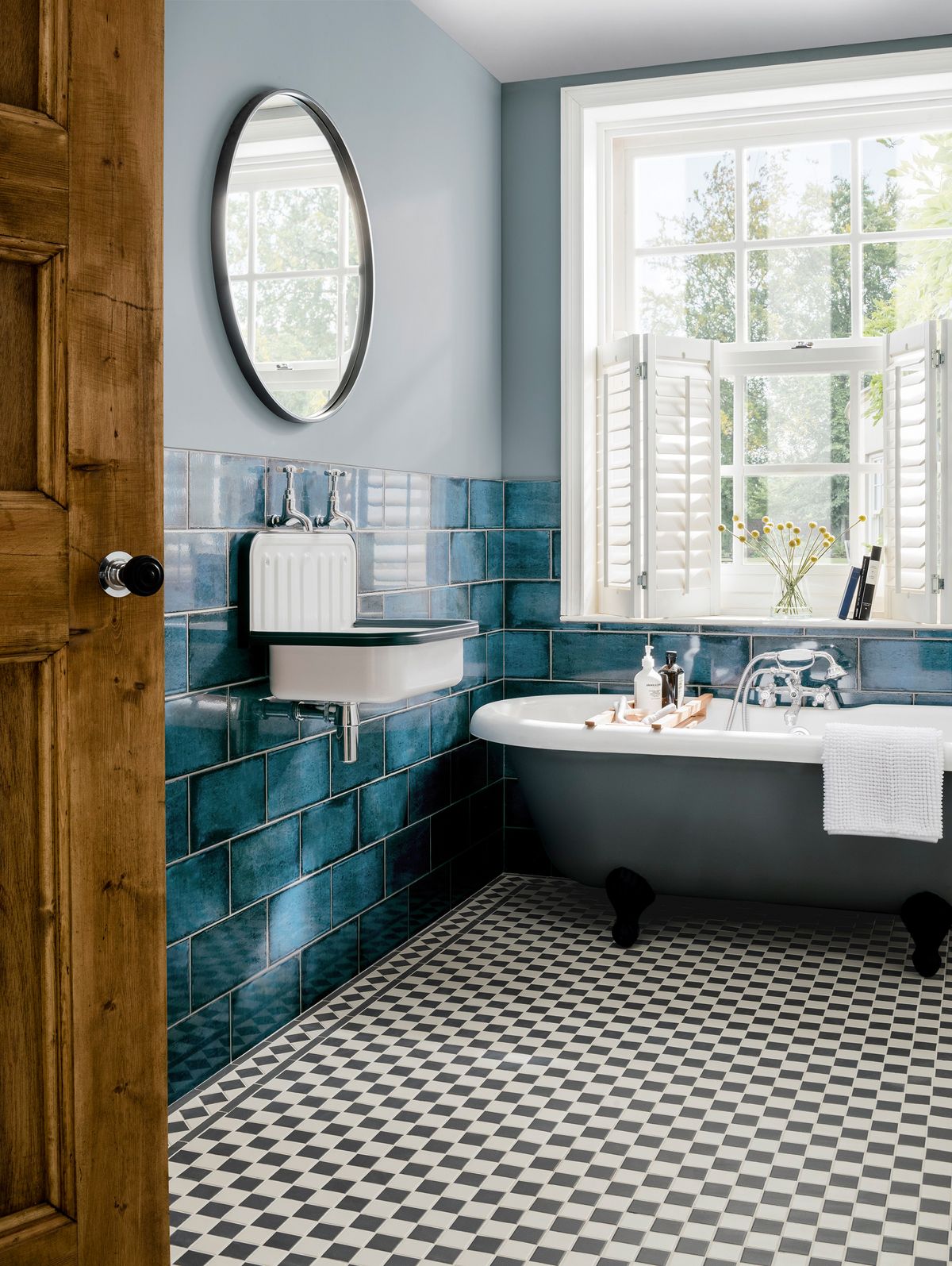Choosing the Right Material for Bathroom Floor Tiles
When I started searching for bathroom floor tiles, I quickly learned that the material plays a huge role in how the tiles perform in a high-moisture space. Here’s what I found out about the best options and why they work well in a bathroom.
- Ceramic and Porcelain Tiles for Durability
Ceramic and porcelain tiles are some of the most popular bathroom floor materials, and for good reason. They’re waterproof, stain-resistant, and come in endless styles and colors. Porcelain is particularly dense, which makes it slightly more durable than ceramic, but both are great options for withstanding bathroom humidity. - Natural Stone for a Luxurious Touch
Natural stone, like marble, slate, and travertine, offers an elegant, timeless look that instantly elevates the bathroom. While stone requires sealing to prevent water damage, its durability and unique, natural patterns make it a stunning choice if you’re willing to maintain it properly. - Vinyl Tiles for Budget-Friendly Versatility
Vinyl tiles are an affordable, easy-to-install choice that has come a long way in recent years. With many designs that mimic wood or stone, vinyl tiles are a durable and waterproof option, perfect if you’re looking to stay within a budget. - Glass Tiles for a Reflective, Modern Look
Glass tiles are unique and add a reflective quality that can brighten a small bathroom. While I don’t use glass tiles for the entire floor, adding them in a mosaic pattern or around the shower floor brings an eye-catching, contemporary feel. - Cement Tiles for a Bold Statement
Cement tiles are known for their colorful patterns and artisanal charm. They do require sealing but are very durable once sealed. If you’re interested in bold designs that make the floor a focal point, cement tiles can add that artistic touch. - Considering Slip Resistance
When choosing material, I always check for slip resistance, especially in wet areas. Many tile options come with textured or matte finishes, which add an extra layer of safety and make them more suitable for bathroom floors.

Popular Bathroom Tile Patterns and Layout Ideas
Deciding on the right pattern was one of the most fun parts of my bathroom remodel. Here’s a breakdown of popular bathroom tile patterns that can make a huge impact.
Classic Subway Tile Layout
The classic subway tile is timeless and clean. Laid in a simple horizontal pattern, it brings structure to the space, and I found that it works well with both small and large tiles for a modern, versatile look.
Herringbone Pattern for a Dynamic Look
The herringbone pattern is a favorite of mine for adding movement to the bathroom floor. Laying rectangular tiles in a V-shaped, zigzag pattern, creates a sophisticated look without overwhelming the space.
Basketweave Pattern for Vintage Charm
Basketweave patterns use small tiles to create a woven effect, often seen in classic bathrooms. This layout brings a vintage touch, and the smaller tiles add grip, making it practical for wet floors.
Hexagon Tiles for a Retro Vibe
Hexagon tiles offer a playful, retro vibe that’s both trendy and timeless. I like how they can be laid in monochrome or multi-colored designs to add visual interest, and the small shape works well in tighter spaces.
Large Format Tiles for a Seamless Look
Using large tiles reduces grout lines, making the floor appear more seamless and the bathroom feel larger. If you’re going for a minimalist look, this pattern can add a sleek, modern touch.
Diagonal Layout for Added Depth
Diagonally laid tiles can make a small bathroom appear larger by creating the illusion of depth. I find this layout works especially well with square tiles, as it adds a subtle, stylish twist to standard tiling.
Pros and Cons of Large vs. Small Bathroom Floor Tiles
Choosing between large and small tiles depends on your bathroom size and the look you want. Here’s what I discovered about both options.
Large Tiles for Fewer Grout Lines
Large tiles mean fewer grout lines, which can give a clean, uninterrupted look and make the room feel more spacious. This is ideal if you prefer a minimalist design with fewer visual breaks.
Small Tiles for Flexibility in Tight Spaces
Small tiles are easier to fit in small or awkward spaces. When I tiled around fixtures, smaller tiles allowed for better coverage and less cutting, which made the installation process simpler.
Large Tiles for a Modern Aesthetic
Large tiles often give a more contemporary look. If you’re into modern designs, large tiles offer a sleek surface that’s both easy to clean and visually striking in a spacious bathroom.
Small Tiles for More Traction
Smaller tiles mean more grout lines, which can add extra grip on a wet bathroom floor. For showers or wet areas, this is a big plus, as it can reduce slipping risks.
Large Tiles in Light Colors for a Spacious Feel
Light-colored, large tiles can visually open up a bathroom, making it feel larger and brighter. I found this especially helpful in a small bathroom, where maximizing space was a priority.
Small Tiles for Creative Patterns
If you love intricate patterns or mosaic designs, small tiles are the way to go. They allow for greater design flexibility and can be combined in patterns that large tiles simply can’t achieve.
How to Choose the Best Color for Bathroom Floor Tiles
Choosing the right color was crucial for setting the bathroom’s mood. Here’s what I learned about selecting the perfect color for bathroom floor tiles.
Light Colors to Open Up Small Spaces
Light-colored tiles, like whites and soft neutrals, make a small bathroom feel airy and open. I noticed they reflect light better, creating an illusion of more space, which is great for compact bathrooms.
Dark Colors for a Cozy, Elegant Look
Dark tiles, like charcoal or navy, add a cozy, luxurious feel. Although they can make a space feel smaller, pairing them with light walls or fixtures can keep the room balanced and stylish.
Neutrals for a Timeless Appeal
Neutral tones, like beige or gray, offer a versatile base that pairs well with most decor styles. If you prefer a classic look that can evolve with changing trends, neutrals are a safe, timeless choice.
Bold Colors for a Statement Floor
Bold colors, like teal or emerald green, can create a standout bathroom floor that adds personality to the space. For a unique look, I sometimes consider adding a pop of color to a single feature area.
Cool Tones for a Calm, Spa-Like Feel
Cool colors, like blues and greens, bring a serene, spa-like vibe to the bathroom. They create a relaxing atmosphere, and when paired with natural elements like plants or wood, they feel very inviting.
Patterned or Mixed-Color Tiles for Added Texture
Patterned tiles in complementary colors add texture and depth to the floor. Mixed-color tiles, especially in muted tones, add subtle visual interest without overpowering the rest of the decor.
Slip-Resistant Bathroom Floor Tiles for Safety
Safety is always a priority in the bathroom, so I focused on slip-resistant tiles to keep things safe and stylish. Here’s what I found.
Opt for Textured Surfaces
Textured tiles are a simple solution for slip resistance. They provide extra grip underfoot, which is essential in wet areas like around the shower or tub.
Matte Finishes for Less Slippage
Matte finishes are less slippery than glossy tiles, especially when wet. I found that they provide a good balance of style and functionality, making them ideal for bathrooms.
Choose Smaller Tiles with More Grout Lines
Smaller tiles with more grout lines add extra traction, which can reduce slipping risks. This is especially helpful in the shower area where slipping is a concern.
Consider Anti-Slip Coatings
Some tiles come with anti-slip coatings or can be treated with anti-slip products post-installation. I found this to be an excellent solution for tiles that need extra grip but come in glossy or smooth finishes.
Rubber or Vinyl Mats for Extra Protection
Adding rubber or vinyl mats in high-traffic areas can boost safety without altering the look of the tile. Mats provide a simple, removable option to enhance grip where needed.
Opt for Slip-Resistant Tile Ratings
Many tiles come with a slip-resistance rating (R-rating). Choosing tiles rated R10 or above can give peace of mind, knowing they’re designed specifically for wet, high-moisture areas.
Budget-Friendly Bathroom Tile Options That Don’t Compromise on Style
Finding stylish tiles on a budget was easier than I thought. Here are some affordable options that still look fantastic.
Ceramic Tiles for Affordable Durability
Ceramic tiles are budget-friendly and highly durable. They come in a range of styles, making it easy to find an affordable option that doesn’t sacrifice style.
Vinyl Tiles for Realistic Designs
Vinyl tiles can mimic wood, stone, and other materials at a fraction of the price. I love how they’re waterproof and easy to install, which makes them an ideal option on a budget.
Porcelain Tiles for Long-Term Savings
While porcelain might have a slightly higher upfront cost, it’s very durable, meaning I save on repairs or replacements over time. For a budget-conscious buyer, porcelain is a wise investment.
Peel-and-Stick Tiles for Easy DIY
Peel-and-stick tiles are perfect for DIY projects and budget renovations. They’re easy to install and come in various designs, from classic subway tiles to modern patterns.
Mix and Match to Create Unique Patterns
Mixing different affordable tile options can create a custom look without overspending. I experimented with alternating tile colors to add texture and save costs without sacrificing style.
Explore Remnant or Overstock Options
Many stores offer discounts on tile remnants or overstock tiles. This was a great way for me to find high-quality tiles at a reduced price, which allowed me to complete my bathroom on a budget.
Related Posts:




